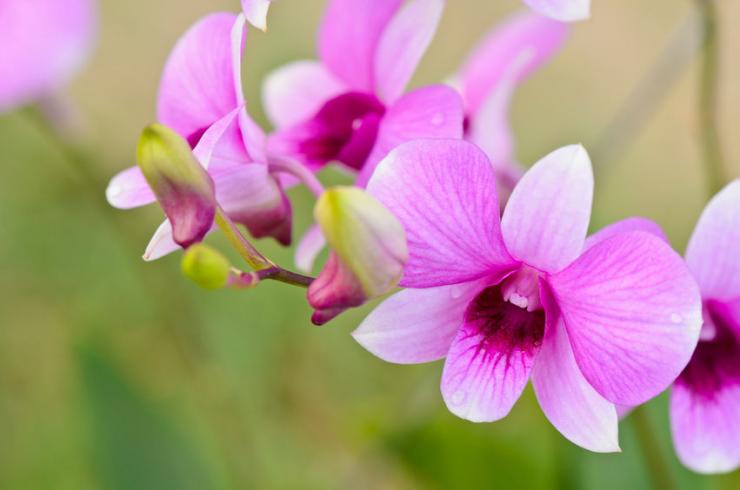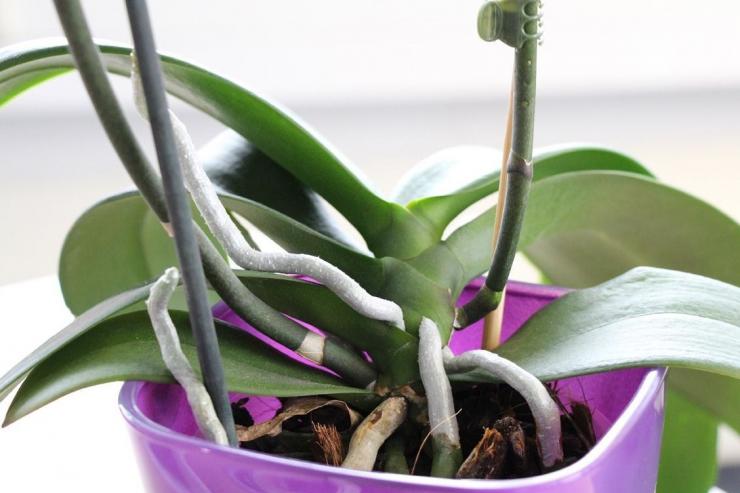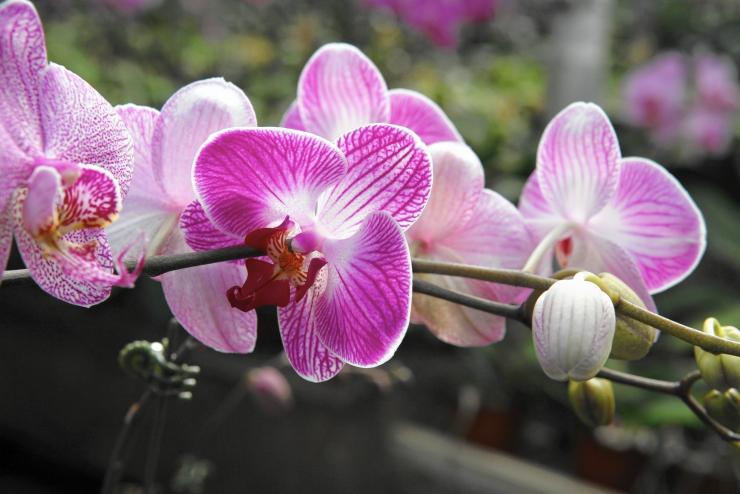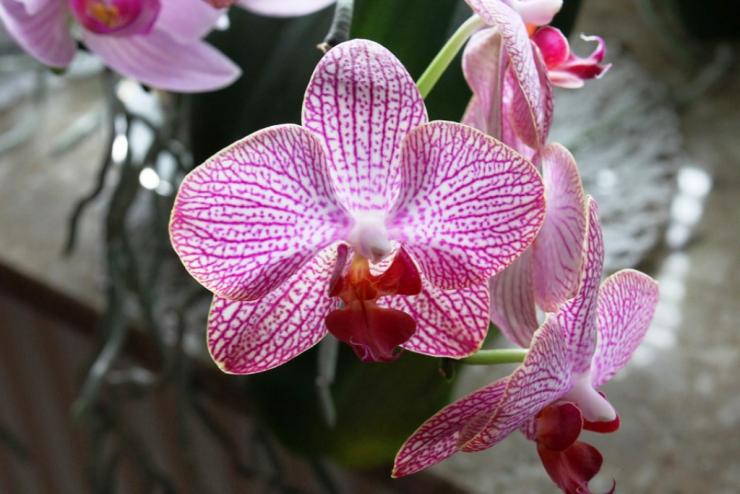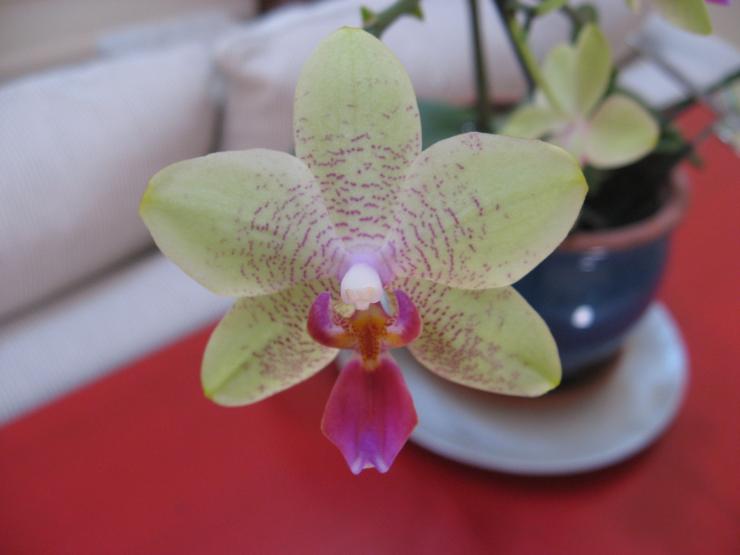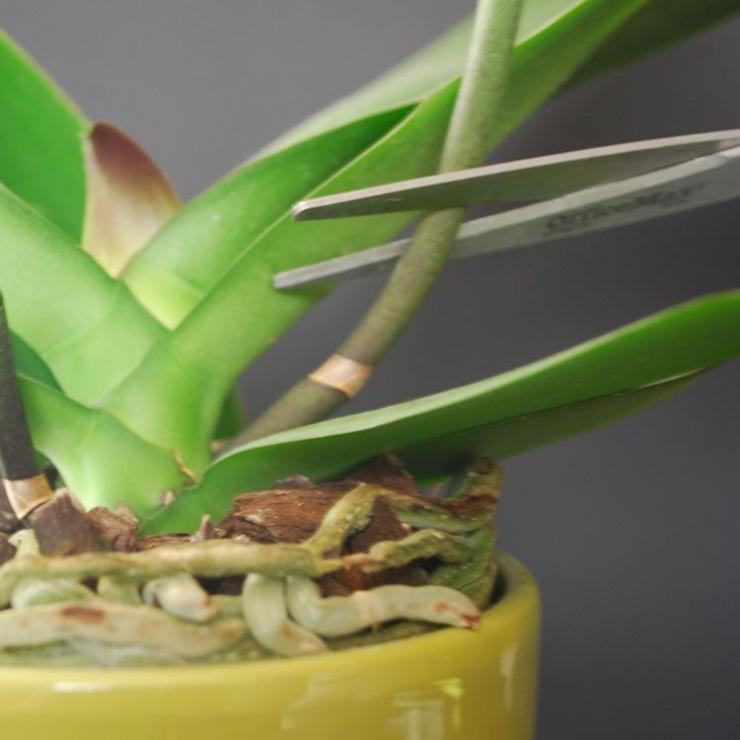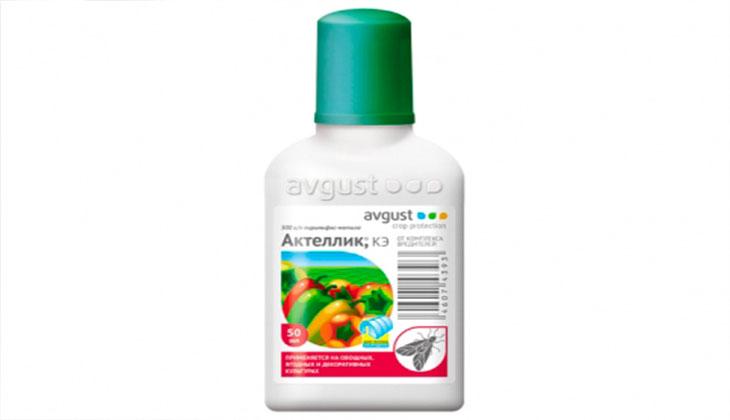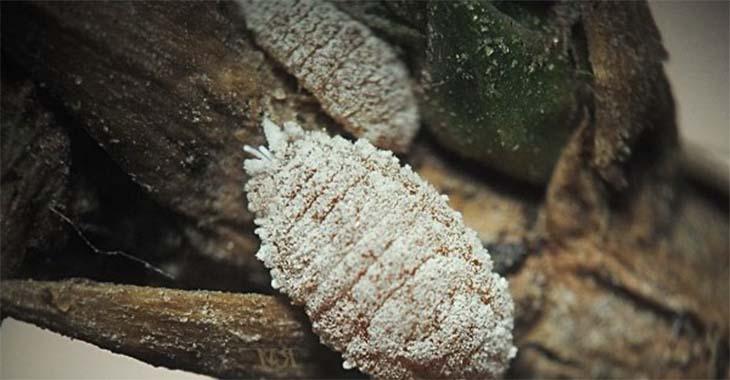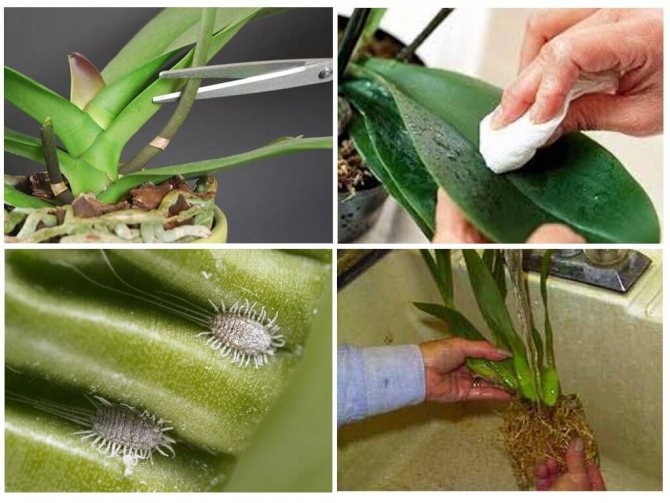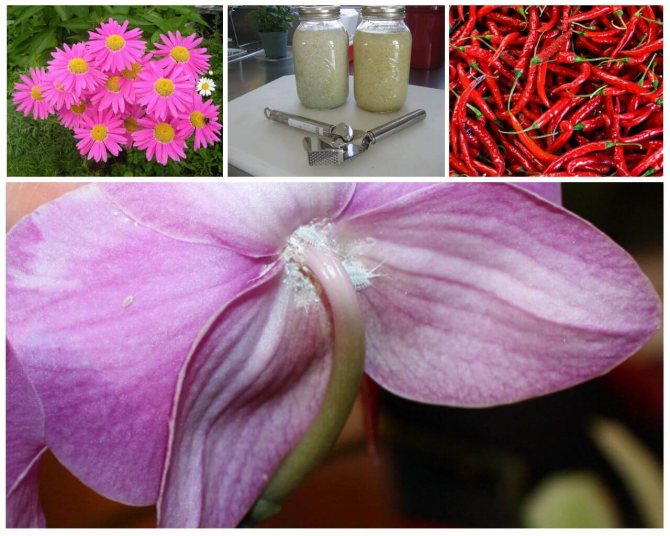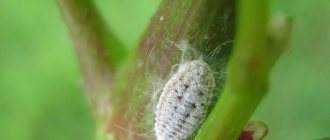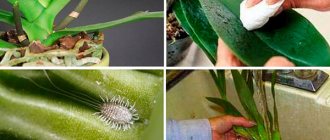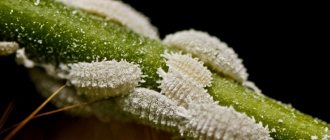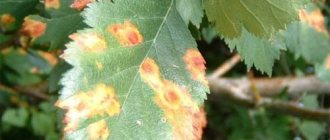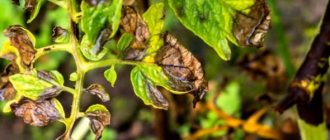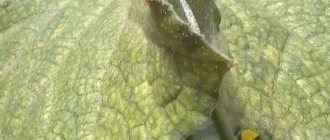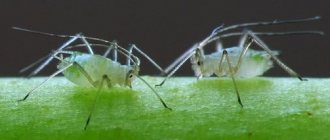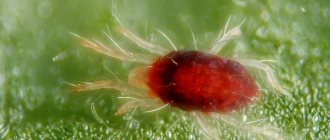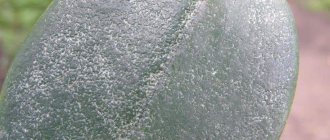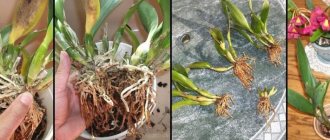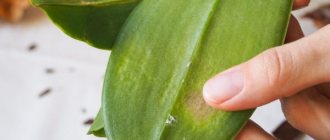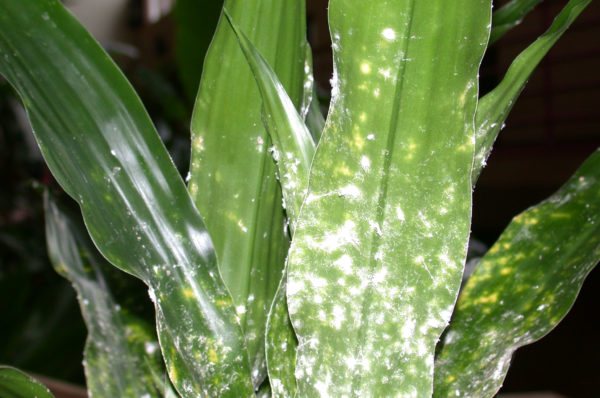
Mealybug is an insect that is found on an orchid, not everyone knows how to get rid of it. Recognizing a pest is easy. If the plants are processed in a timely manner, it will be possible to protect them from insects.
How to get rid of a mealybug on an orchid is of interest to many gardeners. The plant is exotic, the queen of indoor flowers. Despite the fact that flowers grow indoors, they cannot be completely protected from pests. To save plants, you can use folk methods or chemicals.
Reasons for the appearance of a mealybug on an orchid
Insects choose weakened plants kept in violation of the conditions for their habitat:
- unsuitable temperature regime;
- insufficient or excessive lighting;
- improper feeding.
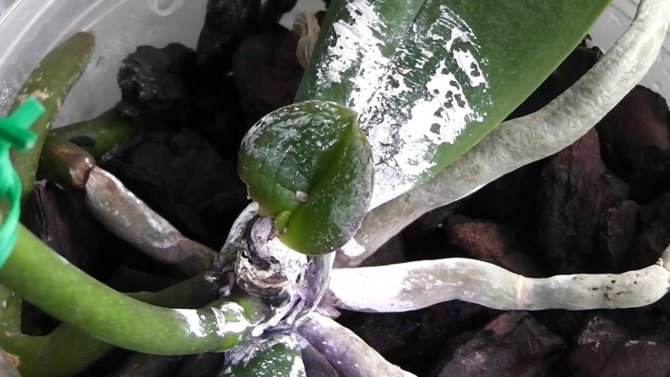

Mealybug infestation
The most popular among mealybugs are orchids, which receive an excess of fertilizers containing a large amount of nitrogen.
Domestic flowers are attacked by the parasite mainly in winter. At this time, there is a decrease in daylight hours, and orchids experience a lack of natural light. Some plant lovers forget about the backlight, besides, the humidity indicator changes, because the heating system starts its work.
Reasons and stages of the struggle
We single out a group of main reasons:
- Frequent feeding with nitrogen fertilizers.
- Dryness or excessive humidity in the room.
- Frequent watering - water stagnates in the ground.
- Contaminated soil.
- Fallen withered leaves, withered flowers in a pot. They start to rot and are a "house" for parasites.
When infected with powdery mildew or mealybug, various therapeutic measures are required. But mandatory general actions:
- isolating the infected orchid from other plants;
- removal of all damaged parts (leaves, buds), cover the cuts with crushed activated carbon;
- only after the removal of the infected leaves can the treatment begin.


Powdery mildew on an orchid
Types of mealybugs
Mealybug - how to deal with indoor plants
The Hemiptera family includes more than 2,200 different species, including the orchid pest. Plants suffer most from bristly and citrus bugs. It is worth getting to know these parasites in more detail.
Bristly
Adults have the shape of a long oval body of about 3.5 mm. The color can be orange or pinkish, there is always a white bloom. The parasite has well-developed limbs, which allows it to easily move from one plant to another. Most often, the worm can be found on the undersides of the leaves, in their axils. Pests live in colonies.
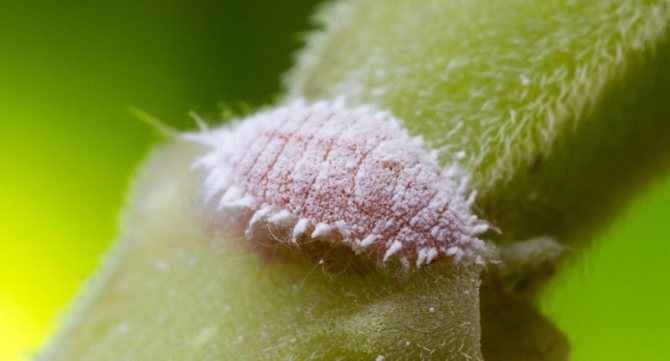

Bristly mealybug
It is quite simple to notice the bristly worm - after it there is a powdery coating of white color and waxy formations, similar to cotton lumps, they are also white. After damage, the leaves begin to turn yellow and subsequently fall off.
Citrus
Individuals have a variety of color variations, there are both light yellow and brown. It is typical for females to secrete a sweet secretory fluid, which is also called padya.Males have the ability to fly, look like flies with yellow and pink colors.
What does it look like
Mealybugs have been encountered by many orchid lovers. The insect is a member of the Hemiptera family, which has an external resemblance to the scale insects. The oval, slightly flattened body of adults reaches up to 5 mm. The surface of the body is covered with a white, sometimes barely pink, powdery bloom with fringes along the edges, which is why the pest got its name. The mealybug is the owner of the sucking mouth apparatus. What an insect looks like can be seen in the photo.


Mealybug on orchids Insect-infested areas of the plant are marked with white filaments that resemble spider webs or cotton wool. Females usually lay eggs under it. Therefore, the presence of furry balls on a green pet means that a mealybug has appeared on an orchid.
On a note!
Pests rarely infect a plant with proper care. Therefore, the appearance of mealybugs on orchids is evidence of insufficient attention and poor-quality care for a green pet.
Methods of dealing with the worm at home
White bugs on an orchid: ways to get rid of pests
Removing parasites is not as easy as it seems. When conditions are unfavorable, insects release wax in large quantities, which will protect them from the effects of chemicals. Eggs cover the cottony fibers from harm.
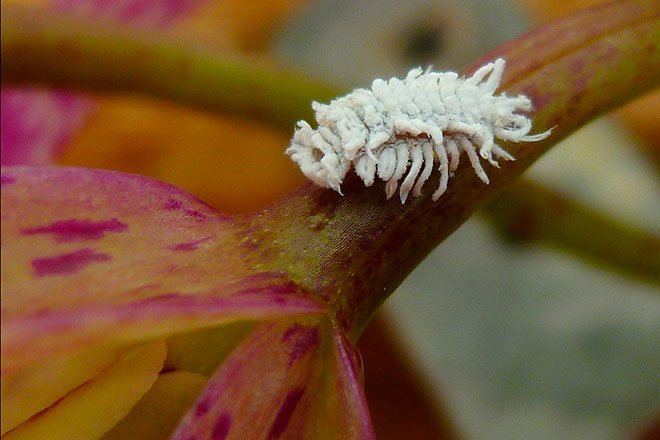

Citrus mealybug
If a mealybug is found on orchids, then the plants must be isolated from others. As for the methods of struggle, then it is necessary to look at the degree of spread of the infection.
Signs of infection
The following symptoms indicate that a mealybug has appeared on orchids:
- the presence of flour plaque on leaf plates;
- the appearance on the leaves of honeydew - sticky secretions;
- the formation of light spots in the damaged areas of the leaf.
In an orchid infected with a worm, the leaves begin to turn yellow, wilt, and then the leaves fall off. The buds of flowering plants and already blossoming flowers are also affected. A large number of pests contribute to the deformation of young shoots.
It is impossible to confuse a worm with another insect. The main sign of plant damage is the appearance of a white waxy coating. It looks like a piece of cotton wool.
In addition, sticky secretions appear on the leaves. The plates are stained. If you do not immediately take measures to destroy the pest, the plant will soon die.
Prophylaxis
The flower must be watered with a dried substrate. The watering depth is 1 cm. In case of accumulation of liquid in the sump, it is emptied. The pot containing the flower is constantly cleaned of debris and dead foliage. Also wash the shelf of pots regularly using hot water.
In the summertime, the larvae of the parasite enter the room due to gusts of wind. For this reason, the plants are periodically inspected, suspicious specimens are isolated from the rest.
New flowers are quarantined: they are placed separately and carefully observed. If there is a suspicion of infection with harmful insects, the orchid is immediately treated with folk remedies or an insecticide solution.
Description of pests
Orchids are harmed by citrus and bristly mealybugs shown in the photo in the article. The roots are parasitized by soil species of this insect family. Among the people, these parasites were named "felt" and "hairy lice", reflecting the peculiarities of the appearance of females. Harmful organisms feed on succulent shoots and leaves, causing great damage to plants. The winged male does not consume food for a short life.
What hairy lice look like:
- The body of the female has a rounded shape and is 3–6 mm long.
- Females secrete white wax threads, wrap themselves in this felt.
- Males are winged insects, with two slender outgrowths at the back of the body. The body reaches a length of 2 mm.
- The larvae look like small yellowish worms that crawl around the plant in search of food.
The color of the bristly worm is red or orange. On the back of the body, thin tendrils grow. The body of a female citrus bug is pink or yellow. From above, the insects seem to be sprinkled with flour or powder. This effect appears due to the many wax plates.
Usually females sit motionless or crawl slowly, then stick in one place. Insects feed intensively and form an egg sac from wax filaments. There are viviparous varieties and species capable of reproduction without fertilization - parthenogenesis. The larvae move quickly, find a place to feed and prepare to molt.
Phalaenopsis affects 2 types of these parasitic organisms: citrus and bristly. Soil varieties are parasitic on the roots. Other subspecies use succulent shoots and flower leaves as food. Due to the wax coating that covers the body of the pest, they are popularly known as hairy lice or felt lice.
Description of the appearance of the parasite:
- The body of the female is rounded. Its length reaches 3-6 mm.
- From above, the body of females is covered with white threads.
- The body size of a male mealybug is 2 mm.
- Outwardly, the male of the parasite is a winged insect with 2 outgrowths located in the back of the body.
- The larvae look like yellowish worms. They move through the leaves of the orchid, trying to find food.
Females are usually motionless or move at a low speed. After that, they stick to the flower in one place and are heavily nourished by it. During this process, females form a egg-laying sac of wax filaments.
We offer you to familiarize yourself with: What smell mice do not like, a humane way to fight rodents
Larvae move faster than adult insects until they find a place to feed. After that, they gain strength and prepare for the molting process.
The easiest way to kill parasites on orchids is at the beginning of the infestation. Sites of potential infection are carefully examined. Peduncles, foliage and young shoots are cleaned of egg sacs and female mealybugs using a gauze swab. After the plant is wiped with a cotton swab dipped in alcohol tincture of calendula.
Due to the invasion of insects, there is a high probability of developing bacterial, fungal and viral diseases. Pests are more likely to appear in highly crowded conditions.
Infection of the root system with mealybug
Sticky drops on orchid leaves: causes and treatments
When the parasite appears in the roots, the process of decay can begin, which will lead to the death of the plant. To rid a flower of insects, you need:
- Remove the orchid from the pot, remove the substrate;
- The product is diluted, according to the instructions, in a container of a suitable size, where the plant is then placed. Processing time should be specified, if not, then 20 minutes will be enough;
Important! Processing is carried out several times. The plant itself between procedures is in a pot (it must be new and clean) without soil.
Diseases and treatments
Phalaenopsis are prone to infectious and non-infectious diseases. In both cases, care errors are the dominant cause of the illness. The most common phalaenopsis disease is the fungus fusarium. The affected orchid will develop root disease first. Further, the disease spreads throughout the plant.The dominant cause of fungus is excess moisture. The fungus cannot be treated and the flower has to be destroyed. Other types of rot (from gray, brown, root and black to rust, mottling and anthracnose) are often cured by double treatment with a fungicide or analogs (basezol or topsin-M), observing a ten-day interval. Urticaria is also quite common. It infects leaves with noticeable spots of 2 - 3 cm in size. The reason lies in the low air temperature, too high humidity and / or poor air exchange in the room. After eliminating these deficiencies, the plant recovers. The same disadvantages can cause another disease - botrytis. The object of damage in this case is the petals. First, they become covered with dark spots, after which they wither and fall off. The rise in temperature slows the spread of the disease. It will not be superfluous to equip high-quality ventilation and treatment with any bactericidal preparation. The causes of noncommunicable diseases are the use of pesticides, excessive lighting, inadequate feeding and uneven watering. As a result, the tips of the leaves may dry out, the roots may become dead, spots may appear, etc. After eliminating the causes of the disease, the chances of saving the plant increase, but it should be remembered that resuscitation is a rather laborious and not often successful process.
Watch closely the tones of your plant
Preventive measures
Any disease is always easier to prevent than to cure, therefore there are a number of measures to prevent the appearance of a mealybug:
- Purchased orchids must be quarantined for 14 days to ensure that the plants are healthy.
- Periodic inspections of flowers for the appearance of pests. Small colonies of worms are much easier to destroy.
- Control over the correct conditions of detention. Healthy plants are rarely attacked by parasites.
The appearance of diseases and pests on orchids is not a reason for panic. First of all, problematic specimens are isolated, and treatment begins. In the larval stage, worms even survive chemical treatment; it is necessary to return the plants to their permanent residence only after their complete recovery.
Chemicals
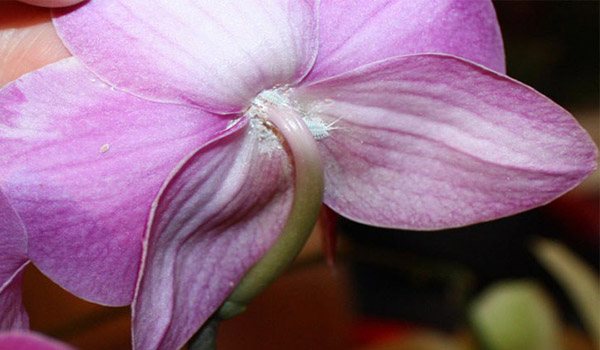

How to remove a mealybug from an orchid? The use of chemicals, i.e. spraying with an insecticide, is considered a last resort. This method is used by flower growers only when folk methods of struggle are no longer helping the orchid.
In flower shops, special contact insecticides are sold to combat parasitic insects. They are applied to the surface of infected orchid leaves and branches. Such drugs scare away or destroy parasites.
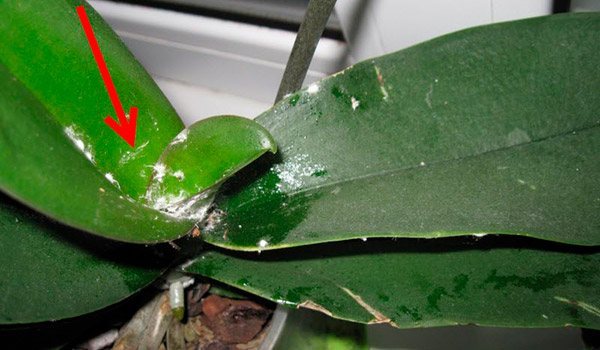

In addition, there are so-called systemic plant treatment chemicals. The principle of their effect on parasites is completely different. These substances are absorbed by the plant and infect insects when they suck the juice out of it. Simply put, the poison is spread precisely through the sap of the plant.
Of course, these drugs have an undeniable advantage: they are not sprayed, but permeate the soil. As a rule, one watering is enough to completely destroy the mealybug. The disadvantage is that the drug negatively affects the plant itself - under its influence it also weakens, it must be fed abundantly, and it is better to completely replace the soil in the pot after the parasites disappear. The most affected parts of the plant are cut off.
Ways to fight
It is very difficult to get rid of the pest, because the bodies of the females are covered with a protective wax coating. In addition, the worm reproduces very quickly and secretes fluid, which is an ideal breeding ground for fungi and attracts other insects.There are several methods of pest control.
Mechanical method
This method is the first step in the difficult fight against mealybugs. First, you need to cut off all orchid flower stalks affected by the pest. Then, using a solution of laundry or green soap and a sponge, remove insects from the leaves and pseudobulbs. If the worms are firmly entrenched in the leaf sinuses, then they must be carefully removed from there with tweezers or a cotton swab.
Then you need to remove honeydew by thoroughly rinsing the plant in the shower. But before flushing, you must make sure that all pests are removed, otherwise they will simply be washed away into the soil. It is very difficult to get them out of the soil, and the damage they can cause to the roots is significant.


Traditional methods
Folk remedies, most likely, will not help completely get rid of the worm, but they will stop its development. To combat the pest, all kinds of tinctures with laundry soap, alcohol, oils are used. The main thing is to mix all the ingredients well and let them infuse. A warm soapy alcohol solution is used to wipe the leaves. It is especially necessary to wipe the places where cocoons accumulate. You can also use a garlic tincture, a mixture of olive oil.
Some growers recommend using calendula tincture for wiping. For spraying, use a tincture of horsetail. Hot showers or heat can be used, but care should be taken to avoid scalding the leaves.
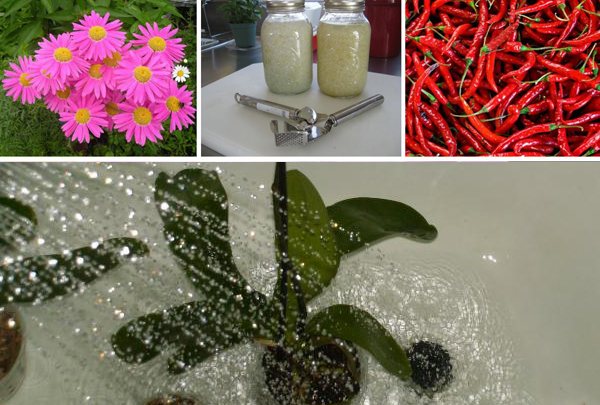

Chemicals
Certainly, chemicals - insecticides - are the most effective remedies. But they help only at the stage of fighting the larvae. Contact-intestinal pesticides are more effective against all plant pests. But they can harm human health, so you need to process the flower strictly according to the instructions, observing all safety rules.
Less toxic are drugs of natural origin - "Fitoverm" and "Vermitek". The potent "Aktara" and "Calypso" will help to effectively cope with the pest.



